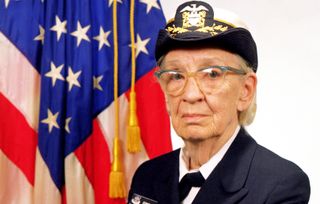begin quote from:
Grace Hopper: 'First Lady of Software'

Grace Hopper's work with computers helped NASA communicate with Apollo astronauts, and still helps scientists keep track of far-flung spacecraft.
(Image: © U.S. Navy)
Grace Hopper was a computer scientist who is best known for helping to create the first all-electronic digital computer, called UNIVAC (Universal Automatic Computer). NASA's tracking stations for the Apollo moon missions used UNIVAC hardware to communicate with the astronauts. In 2016, Hopper posthumously received the Presidential Medal of Freedom for her contributions.
"Known as 'Amazing Grace' and 'the first lady of software,' [Hopper] was at the forefront of computers and programming development from the 1940s through the 1980s," the citation read. "Hopper's work helped make coding languages more practical and accessible, and she created the first compiler, which translates source code from one language into another."
Hopper's life
Hopper was born in New York on Dec. 9, 1906, and attended Vassar College. She graduated in 1928 with a mathematics degree, then received master's and doctorate degrees in mathematics and physics from Yale University in 1934, according to the U.S. Navy.
At the height of World War II, in 1943, she enlisted with the Women Accepted for Volunteer Emergency Service (WAVES). She was 37 years old, far older than most military recruits. In 1944, she was assigned to the Bureau of Ordnance Computation Project at Harvard University.
Some of the work she did there still echoes in the lingo of computer programmers today. For example, she used the word "bug" to talk about a computer malfunction. She also created a model of an electric computer called the Mark I.
She finished active duty in 1946, but remained in the Naval Reserve as a contractor for the Mark II and Mark III computers, the Navy said on another web page. Her work on the UNIVAC occurred after 1949, when she joined Eckert-Mauchly Computer Corp. (later known as Sperry-Rand, then Sperry Corp., which now exists in parts today in Unisys, Honeywell and Sperry Marine.)
Besides helping to create UNIVAC, she also created the first computer compiler (which translates source code from one language to another) and also made a new programming language that was "a widely used framework for coding languages at the time," the Navy said. That language was called FLOW-MATIC, and is a basis of the widely used Common Business Operating Language (COBOL).
Hopper's connection with the Navy persisted for most of her life. She retired from the reserves in 1966, then returned for active duty in 1967 for what was supposed to be six months — but for what ended up being 19 years. By the time of her involuntary retirement in 1986 at the age of 79, Hopper was one of the few female flag officers, achieving the rank of rear admiral (lower half.) She died in 1992 at age 85, leaving behind a collection of papers donated to the Smithsonian Institution.

Hopper's space legacy
In general, Hopper helped contribute to the field of computer programming, without which Apollo would never have been possible. For example: Advanced guidance and navigation software (for its time) ran on the Apollo command and lunar modules, allowing the spacecraft to find their way to the moon and for the lunar module to land on it.
More specifically, however, Hopper's co-creation of UNIVAC was instrumental to the Apollo missions. Apollo required a different form of communication than the Earth-orbiting Mercury and Gemini missions, which used C-band communications (and others) to stay in touch with Earth, according to ZDNet. Because the astronauts would be much farther away, NASA created a Deep Space Tracking Network — still in use today — to keep tabs on distant robotic missions across the solar system.
"Each of the three DSTN stations were composed of huge 85-foot wide movable radio dishes, radio signal decoding equipment as well as a computer room which contained UNIVAC 1230 systems," ZDNet wrote in 2014.
These systems, the website added, "processed a continuous 48kbps data stream from the Apollo spacecraft using its on board S-band radio transmitter on the command and lunar modules. Each of those spacecraft modules had the ability to demodulate (and remodulate) information for transmission back to Earth."
The Deep Space Network is still used today for many missions, including the Mars Curiosity mission, the New Horizons mission (which passed by Pluto in 2015) and Voyagers 1 and 2, which both flew past several planets in the 1970s and 1980s and are still voyaging outward into deep space.
Join our Space Forums to keep talking space on the latest mission
No comments:
Post a Comment